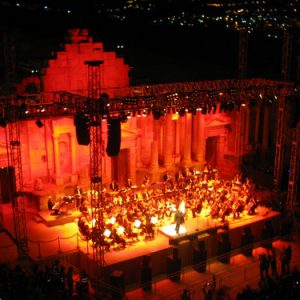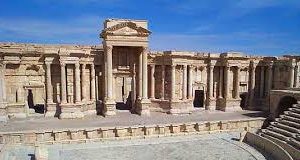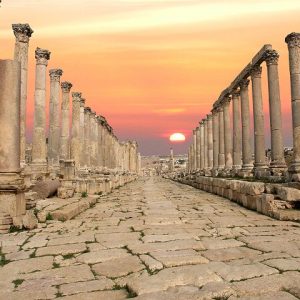Jerash (The Roman Ruins)
Located 48kms north of Amman, Jerash is internationally acknowledged as one of the largest and most well preserved sites of Roman architecture in the world outside Italy. Specialists and archeologists have found the ruins of settlements dating back to the Neolithic Age, indicating human occupation of this location for more than 6500 years. Until now, its colonnaded streets, baths, theaters, plazas and arches remain in exceptional condition.
The history of Jerash is a blend of the Greco-Roman world of the Mediterranean basin and the ancient traditions of the Arab Orient. Indeed, the name of the city itself reflects this interaction. The earliest Arabic/Semitic inhabitants named their village Garshu. The Romans later Hellenised the former Arabic name into Gerasa, and at the end of the 19th century, the Arab and Circassian inhabitants of the small rural settlement transformed the Roman Gerasa into the Arabic Jerash. It was not until the days of Alexander the Great in the 4th century BC that Jerash truly began to develop into a sizeable town. But it was during the period of Roman rule that Jerash, then known as Gerasa, enjoyed its golden age.
The first known historical reference to Jerash dates back to the 2nd or early 1st century BC. This reference is attributed to Josephus, a historian from the Holy Land, who referred to it as the the place to which Theodorus, the tyrant of Philadelphia, removed his treasure for safe keeping in the Temple of Zeus. Shortly afterward, Theodorus lost Jerash to Alexander Jannceus, a religious priest. Soon after Rome took control of Syria, Emperor Pompey, in 63 BC, named conquered Jerash as one of the great cities of the Decapolis League. This brought great economic benefits to Jerash and trade flourished with the Nabataean Empire based in Petra.
In 106 AD, Emperor Trajan annexed the wealthy Nabataean Kingdom and formed the province of Arabia. This brought even greater trading riches pouring into Jerash, which enjoyed a burst of construction activity. Granite was brought from as far away as Egypt, and old temples were rebuilt according to the latest architectural fashion. The city received yet another boost in stature with the visit of Emperor Hadrian in 129 AD. To honor its guest, the citizens raised a monumental Triumphal Arch at the southern end of the city. Jerash’s prosperity reached a peak in the beginning of the 3rd century, when it was bestowed with the rank of Roman Colony. During this “golden age”, Jerash may have had a population of 20,000 people.
The ancient city preserved today was the administrative, civic, commercial and cultural center of this community, while the majority of the city’s citizens lived on the east side of Jerash Valley. As the 3rd century progressed, Jerash fell into decline. Shipping was more and more used for commerce, the trade routes less traveled became therefore less valuable. By the middle of the 5th century, Christianity had become the major religion of the region and numerous churches were constructed in Jerash. Jerash was hit further by the Persian invasion of 614 AD and the Muslim conquest of 636 AD. A series of earthquakes in 749 AD did serious damage to the city and hastened its decline, and its population sank to 4000.
The Crusaders described Jerash as uninhabited, and it remained abandoned until its rediscovery in 1806, when Ulrich Jasper Seetzen, a German traveler, came across and recognized a small part of the ruins. The ancient city was buried in sand, which accounts for its remarkable preservation. It has been gradually revealed through a series of excavations, which started in 1925, and continue to this day. The ancient city also hosts the famous Jerash Festival each year in July, transforming the site into one of the most spectacular cultural event in Jordan.
This summer event includes chariot racing, popular music and arts exhibitions. Local and International folklore dancers and troupes come not only from all over the country but from abroad as well (Germany, Spain, The Lebanon…) to celebrate life. The Jerash Festival is just a ‘must-see’!



